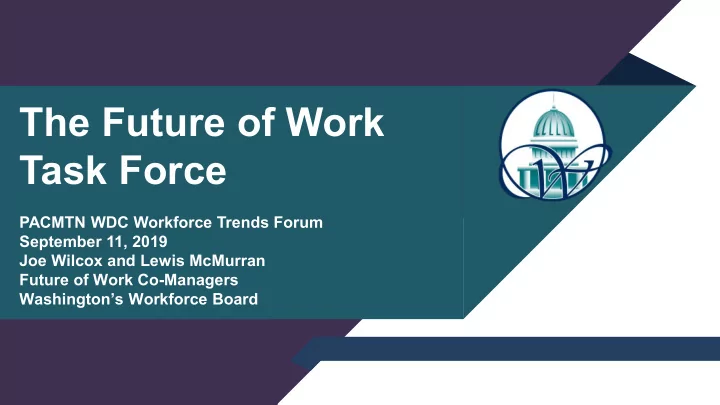

The Future of Work Task Force PACMTN WDC Workforce Trends Forum September 11, 2019 Joe Wilcox and Lewis McMurran Future of Work Co-Managers Washington’s Workforce Board
Fourth Industrial Revolution Washington Workforce Training & Education Coordinating Board
Million Dollar Question How can Washington’s workers and businesses prosper together? Washington Workforce Training & Education Coordinating Board
Washington in the spotlight ▰ In the summer of 2018, Washington’s Legislature created and funded the Future of Work project to investigate this future. ▰ It’s the first of its kind in the U.S. and puts Washington in the spotlight as a thought leader. This included the creation of a Task Force made up of legislators, business and labor leaders. ▰ The Task Force was charged with developing a set of policy recommendations that will benefit both Washington’s workers and businesses. Washington Workforce Training & Education Coordinating Board
Final Report: 2019 By December 1, 2019 final report due to Governor and Legislature that : Describes Task Force activities Presents a set of recommendations Includes a recommendation for research and activities the Task Force would complete if it were to continue beyond sunset date of June 30, 2020. Washington Workforce Training & Education Coordinating Board
Only 9 percent of jobs are at risk of being completely displaced. -OECD 2016 Almost half of US jobs are susceptible to computerization, according - Oxford University Washington Workforce Training & Education Coordinating Board
Preparing Washington’s Businesses and Workforce for the future. The global economy is consistently generating more jobs, but not necessarily prosperity. When shifts occur, it’s usually lower skilled, less educated workers that lose out. Our talent pipeline development systems (education, training, supports) are designed for a bygone industrial economy. Government must transform itself to align with transformations in the economy. Preparing businesses and citizens to compete in any economy by seizing opportunities to reskill through a flexible/customizable lifelong career pathway. Washington Workforce Training & Education Coordinating Board
Supporting Workers ▰ Incumbent workforce at most risk of automation, displacement. ▰ Upskilling, reskilling, retraining, education, entrepreneurship. ▰ Rethinking the safety net in an era of “gig” and nontraditional work. Washington Workforce Training & Education Coordinating Board
Partnering with Businesses ▰ Businesses must be incentivized to innovate. ▰ Businesses have to adopt modern technology to stay competitive. ▰ Businesses must increase resources devoted to people development. Washington Workforce Training & Education Coordinating Board
Which Jobs Have the Greatest Capacity for Automation in Washington? Completely Automatabl Production e Sales Office & Admin. Support Healthcare Practitioners and Technical Construction & Extraction Mostly Architecture & Engineering Automatabl Computer and e Mathematical Inst., Maint., & Repair Mostly Not Business & Financial Operations Automatabl e Legal Management Ed., Training, & Library Not at All Automatable $75K $100K $25K $50K Source: U.S. Bureau of Labor Statistics (2017) and Oxford University, analyzed by Washington’s Workforce Board Washington Note: Bubble size indicates relative size of occupations in terms of number of employees. Orange bubbles illustrate Workforce Training & Education Coordinating Board occupations with highest levels of activities most likely to be automated within the occupational group.
Washington Workforce Training & Education Coordinating Board
Wealth disparity Washington Workforce Training & Education Coordinating Board
Regional Inequity Washington Workforce Training & Education Coordinating Board
Where Are We Now? Washington Workforce Training & Education Coordinating Board
5 Policy Areas 1. Incumbent Worker Training 2. Use and Adoption of Technology in the Workplace 3. Modernized Worker Support System 4. Improved Labor Market Information and Credentialing Transparency 5. Equal Access to Economic Development Resources Washington Workforce Training & Education Coordinating Board
Policy Area – Incumbent Workers ▰ Seeking $25 mil for 2 years for incumbent worker training – retraining and upskilling current workforce is most critical factor in “future of work” scenarios. Public resources necessary. ▰ Extend customized training program/tax credit/job skills program – helps business offset costs of training. ▰ Allow those seeking adult basic education to be eligible for state financial aid. Washington Workforce Training & Education Coordinating Board
Policy Area – Use/adoption of advanced technology ▰ AI, automation and robots are coming quickly and will be disruptive. ▰ Use of AI in the workplace has many implications across organizations that will require all kinds of adaptation. ▰ Workers need to be prepared and brought into the conversation, from both a “cultural” and implementation standpoint. Washington Workforce Training & Education Coordinating Board
Modernized Worker Support System ▰ Public and private worker support and benefit systems created during previous industrial eras. ▰ “Event” based public benefits system; eligible if one loses job or gets injured. ▰ Nothing seamless or portable that helps manage life’s ebbs and flows. ▰ Lifelong learning accounts and portable benefit structures emerging to support workers throughout work/life cycles. Washington Workforce Training & Education Coordinating Board
Improved Labor Market Data/Credential Transparency ▰ Businesses use college degrees as “proxies” for qualifications. ▰ Workers need better “signals” to know what skills and education are really required and in demand. ▰ Labor market data much improved but scattered. ▰ Credential standardization is one way to create better labor market data and signals to business and workers. ▰ Adding occupation field to unemployment reporting improves data collection, ability to report. Washington Workforce Training & Education Coordinating Board
Equal Access to Economic Development Resources ▰ Rural areas of Washington have steeper barriers to economic/workforce development than urban areas. ▰ Robust broadband internet still not ubiquitous across state but moving in right direction. ▰ Employee ownership and cooperatives are proven methods to keep businesses viable. ▰ Use libraries more for community training/education hubs. ▰ Develop networks and capacity for businesses to adopt new tech/processes with engineering/business depts. of state’s colleges. Washington Workforce Training & Education Coordinating Board
Thank you! Joe Wilcox Lewis McMurran joe.wilcox@wtb.wa.gov lewis.mcmurran@wtb.wa.gov 360-709-4631 360-709-4628
Recommend
More recommend